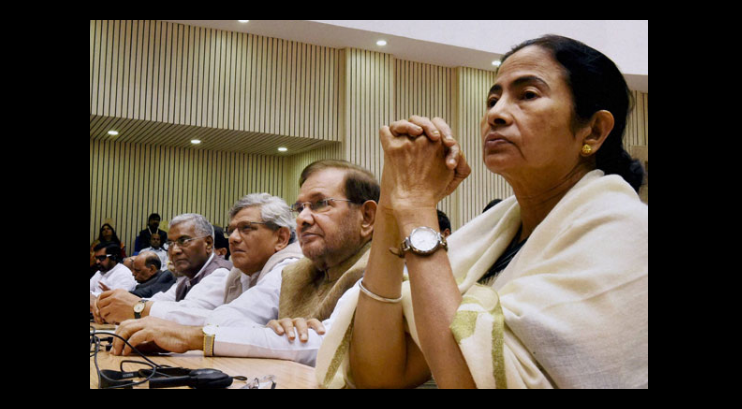The Potential And Limits Of an Opposition Mahagathbandhan
NEW DELHI: It is no secret now that several opposition parties, including some that seemed irreconcilable not so long ago (the Left and the Trinamool and the Bahujan Samaj Party (BSP) and the Samajwadi Party (SP), for instance), are open to the idea of a mahagathbandhan (MGB) to halt the Bharatiya Janata Party (BJP) juggernaut in the 2019 parliamentary elections and bring back a semblance of sanity in Indian polity.
The initial reflection, understandably, is on how the MGB should be pitched so that its arithmetic potential translates into desired electoral outcome - and the not inconsiderable risk of the MGB being popularly perceived as a gang-up against Narendra Modi, who has successfully painted himself as a heroic figure battling phantom saboteurs of every conceivable type, is avoided.
The other issue that merits reflection at this juncture is the extent to which even a well-structured and agenda-wise sorted MGB can impact the BJP’s 2019 chances – and whether it will be sufficient to deny the BJP another stint in power.
The MGB has the potential to dampen the BJP’s prospects in two ways. One: it could deny the BJP the kind of inroads it expects in ‘new’ territories and make its return to power contingent on repeating its impressive 2014 showing in several states. Two: it could dent the BJP’s chances of repeating its 2014 performance in some key states.
Kerala, Odisha and West Bengal – which together account for 83 Lok Sabha (LS) seats (of which only three (3) are held by the BJP currently) - are said to be among the new territories which the BJP is said to be energetically targeting. For starters, the MGB, given the strength of its prospective constituents, should puncture the BJP’s high hopes from Kerala and West Bengal – and, while the shape and direction the anti-BJP coalition takes in Odisha will depend on the outcome of the upcoming assembly elections, a team-up of the two principal non-BJP parties in the state in 2019 can’t conceivably make things easy for the BJP. The BJP’s 2019 tally from these states may still end up higher than its humble 2014 tally but the increase is more likely to be modest than substantial.
Add to the above, the slender chances of the BJP sharply boosting its current tally of six (6) from the 94 LS seats in Andhra Pradesh, Punjab, Tamil Nadu and Telengana (states where it can at best be a junior partner to entrenched parties) and the party could find itself faced with the onerous task of more or less repeating its 2014 showing in the remaining states.
In the event of a MGB, the 2014 performance however may not be easy for the BJP to emulate in at least three large states: Bihar, Karnataka and Uttar Pradesh (UP).
Bihar has already shown what a state-level MGB can achieve and there are good indications of how formidable an alliance of the principal non-BJP parties in Karnataka and UP could prove. The Congress and the Janata Dal (Secular) have together garnered over 50 percent of the vote in Karnataka in each of the last three parliamentary and assembly elections, and the BSP, Congress and SP collectively gathered 50 percent of the vote in the UP assembly elections earlier this year amidst an unprecedented BJP sweep (40 percent vote share, 42 percent with allies).
Even if one were to grant that electoral results won’t completely mirror arithmetically summed chances, it is tough to suggest that the BJP and its allies will not find their current tally (110 of 148 LS seats, 121 with allies) shaved in Bihar, Karnataka and UP when faced with the MGB. In all likelihood, the seats the BJP sheds in these states will be more than those gained in the others discussed so far.
While the above suggest potentially reduced returns for the BJP from a ‘field’ of 325 LS seats, the party will still draw comfort from its chances in the remaining 218. For these lie in states where MGB fortunes will be driven primarily by the Congress. These include states:
where the Congress will need to front the anti-BJP coalition (nearly 100 seats from Assam, Delhi (given what is unfolding in the Aam Aadmi Party), Haryana, Jammu & Kashmir, Jharkhand and Maharashtra);
where the Congress remains the BJP’s chief rival (Chattisgarh, Gujarat, Madhya Pradesh, Rajasthan, plus several small states and Union Territories).
A repeat of the 2009 parliamentary election result when the Congress mustered 103 LS seats and restricted the BJP to 73 in the these states might do the trick for the MGB but the political ground, it needs to be acknowledged, has shifted considerably since.
The BJP currently holds 163 LS seats in these states, has consistently and thoroughly bested the Congress in every large state (barring Rajasthan) where the two parties are directly pitted against each other in recent times, and has registered remarkable performances in the most recent assembly and/ or local body elections in others. Importantly, and encouragingly from the BJP perspective, the Congress doesn’t seem to be in any hurry to get its act together on ground and reclaim lost territory despite regular reversals. (Sachin Pilot’s exertions in Rajasthan are a notable exception.)
Which brings us to the principal limitation of the MGB. It could check the BJP elsewhere and yet find itself trumped, unless the Congress decides to pull its weight and not remain content standing behind regional partners. And that, given the inertia plaguing the Congress at the moment, doesn’t appear imminent. If there’s any consolation that the Congress can draw from all this, it is that it still remains salient to any concerted BJP dethroning effort. (But then it is also the party most likely to be the undoing of such an effort.)





